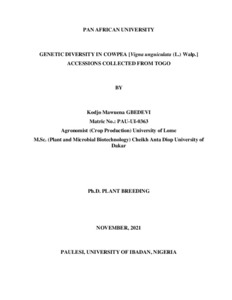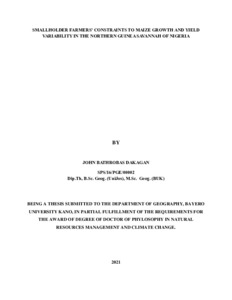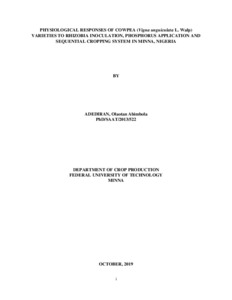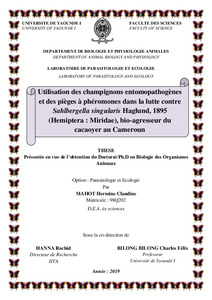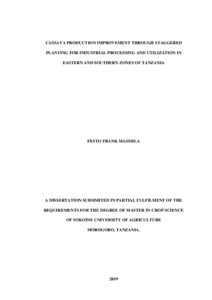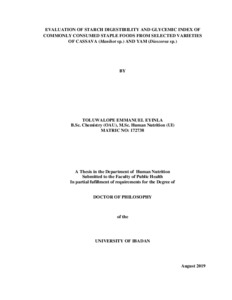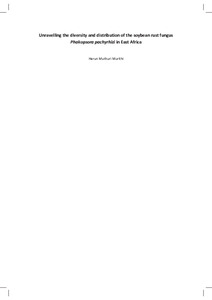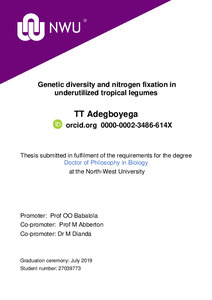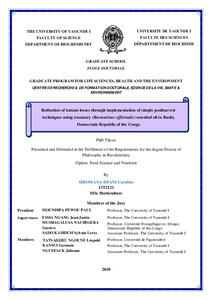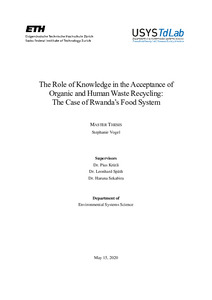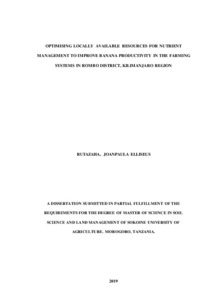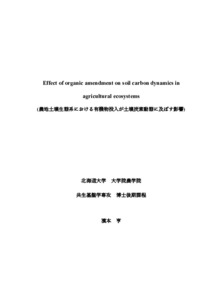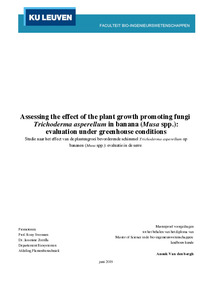Welcome to the International Institute of Tropical Agriculture Research Repository
Theses and Dissertations: Recent submissions
Now showing items 41-60 of 111
-
Genetic diversity in cowpea [Vigna unguiculata (L.) Walp.] accessions collected from Togo
(Pan African University, 2021-11)Cowpea is one of the most widely grown legumes in Togo for its grains and leaves, which are used both as food and feed. Despite its importance in the nutrition and economic life of the people, bulk of the varieties grown in Togo are landraces. Genetic improvement of crops requires the presence of heritable genetic variation. However, there is hardly any information on the extent of variability among cultivated cowpea in Togo. This study was carried out to assess the phenotypic and molecular diversity ... -
Smallholder farmers' constraints to maize growth and yield variability in the northern guinea savannah of Nigeria
(Bayero University Kano, 2021)Maize yield has been on the decline on smallholder farms, where the bulk of maize for different uses is produced in the Northern Guinea Savannah of Nigeria. This study analyzed smallholder farmers‘ constraints to maize growth and yield variability in the Northern Guinea Savannah (NGS) of Nigeria for yield optimization. It temporally covers 2017 and 2018 at 4 Weeks After Sowing (WAS) and 8WAS. For Ikara in Kaduna State and Doguwa in Kano State, 30 and 31 farmers respectively were purposively selected ... -
Comparison of metabolite profile of aflatoxin-contaminated yellow and white maize Ogi after fermentation with lactic acid bacteria and yeast
(University of Ibadan, 2021-01)Aflatoxins are a group of highly toxic, mutagenic, teratogenic, and carcinogenic secondary metabolites of Aspergillus species including Aspergillus flavus and Aspergillus parasiticus. Maize is susceptible to aflatoxin contamination; so, ogi, (fermented maize gruel) consumed as a breakfast cereal, weaning food and food for convalescents is prone to aflatoxins. Therefore, targeted fermentation of yellow and white maize, for ogi, was investigated as a means of aflatoxin decontamination in ogi. Methods ... -
Physiological responses of cowpea (Vigna unguiculata L. Walp) varieties to Rhizobia inoculation, phosphorus application and sequential cropping system in Minna, Nigeria
(Federal University of Technology, Minna, 2019-10)Cowpea is the most important grain legume in Nigeria but the yield obtained on farmers’ fields is far below the potential yield of the crop. This study aimed at exploiting rhizobia inoculation, phosphorus application, varietal differences and sequential cropping system to improve the productivity and profitability of cowpea per unit area in Minna, Nigeria. A glasshouse and two field experiments were conducted between 2015 and 2017. The glasshouse experiment was a factorial combination of four ... -
Utilisation des champignons entomopathogenes et des pieges a pheromones dans la lutte contre Sahlbergella singularis Haglund, 1895 (Hemiptera : Miridae), bio-agresseur du cacaoyer au Cameroun
(University of Yaounde, 2019)Le cacao fait partie des produits qui font vivre plus de 3 millions de personnes au Cameroun. Malgré l’objectif gouvernemental qui vise 600.000 tonnes de fèves de cacao par an à l’horizon 2020, la production cacaoyère reste faible en raison de la pression des maladies et des ravageurs. Dans l’entomofaune nuisible associée au cacaoyer, les hémiptères et précisément les Miridae constituent le groupe d’insectes le plus préjudiciable. De nos jours, la recherche des alternatives à la lutte chimique ... -
Cassava production improvement through staggered planting for industrial processing and utilization in eastern and southern zones of Tanzania
(Sokoine University of Agriculture, 2019)An experiment was conducted with the aim of identifying suitable cassava scheduled planting, harvesting and varietal performance in order to optimize growth, development, yield and quality of cassava during the 2017/18 - 2018/19 cropping season. The experiment was conducted at Naliendele, Nachingwea and Ilonga TARI Research Centres in Tanzania. The experiment was laid out as split-split plot in a randomized complete block design with variety being main factor, harvesting time as sub plot and ... -
Evaluation of starches digestibility and glycemic index of commonly consumed sstaple foods from selected varieties of cassava (Manihot sp.) and yam (Dioscorea sp.)
(University of Ibadan, 2019-08)Consumption of high Glycemic Index (GI) foods is a risk factor for increasing prevalence of metabolic related non-communicable diseases. Cassava and yam are among common staples known to have high GI and are usually avoided by diabetics because they can rapidly raise blood glucose. Currently, it is still unclear if common varieties (and their corresponding products) have different starch digestibility and GI. This study was therefore designed to evaluate starch digestibility and GI of common foods ... -
Unravelling the diversity and distribution of the soybean rust fungus Phakopsora pachyrhizi in east Africa
(Wageningen University and Research, 2019-02)Soybean is an important legume crop that is cultivated worldwide on more than 120 million hectares, producing more than 330 million tonnes of soybeans annually. Soybeans contain 40% of protein and 20% of oil and the crop is therefore used both for human and livestock consumption. Generally, soybean has the potential to significantly improve the nutrition of the inhabitants of sub-Saharan Africa. Soybean production has intensified in Africa over the past 15 years, owing to the raising demand driven ... -
Cassava farmers' insights and seed dealers enterprises in Nigeria
(University of Ibadan, 2019)Seed enterprise is an initiative and risk set up in the production of cassava stems from existing local seed varieties or improved seed varieties for economically sustainable profit. Although, most cassava seeds produced are through informal seed system among smallholder farmers but there is need for replacement strategy for cassava seeds mostly planted over years. Based on this, there is need for intense exploration in the linkage between cassava seed management and diffusion scheme among rural ... -
Genetic diversity and nitrogen fixation in underutilized tropical legumes
(North-West University, 2019-07)Legumes in some cases are underutilized and form only a relatively small proportion of human diets. In general they fix atmospheric nitrogen which may provide an economic advantage for smallholder farmers. By appropriate utilization of legumes, food security and soil fertility can be significantly achieved. During the 2016/2017 and 2017/2018 cropping seasons at the International Institute of Tropical Agriculture (IITA) Ibadan, Nigeria, field and laboratory experiments were conducted to determine ... -
Reduction of tomato losses through implementation of simple postharvest techniques using rosemary (Rosmarinus officinalis) essential oil in Bushi, Democratic Republic of the Congo
(University of Yaounde, 2020)Tomato is perishable and its high moisture content makes it susceptible for various postharvest losses. Tomato quality changes continuously after harvesting when fruits start losing quality because of environmental stress and pathogen infection. Thus, the objective of this research was to propose simple postharvest technology using rosemary essential oil (REO) to reduce postharvest decay. This was done by conducting a field survey in order to determine agricultural potential of soil and environmental ... -
The role of knowledge in the acceptance of organic and human waste recycling: the case of Rwanda's food system
(Swiss Federal Institute of Technology, 2020-05-15)By 2050, the world’s population is expected to increase to 9 billion people. The growing population intensifies urbanization, which puts pressure on the current challenges of food insecurity and environmental pollution. In Rwanda, rural migration and the lack of financial capital to apply sufficient fertilizer result in nutrient-deficient agricultural soils which lead to a decrease in food production. Moreover, the rapid urban expansion leads to environmental pollution and human health risks from ... -
Effect of soil conservation on productivity and food security on maize farmers in northwest Nigeria
(Ahmadu Bello University, 2019-09)The adoption of soil conservation practices is important for sustaining Nigerian agriculture where smallholder maize farmers face constraints such as low soil fertility that lead to low productivity and food insecurity. This study aims to analyze the effect of soil conservation on productivity and food security of maize farmers in Northwest Nigeria. The study used a two year panel data of 792 maize farmers for 2016 and 2017 cropping seasons, collected by IITA under “Taking Maize Agronomy to Scale ... -
Optimising locally available resources for nutrient management to improve banana productivity in the farming systems in Rombo District, Kilimanjaro region
(Sokoine University of Agriculture, 2019)Banana is an important staple food in East Africa and an essential cash crop in the national and local economies. In Kagera and Kilimanjaro regions of Tanzania, banana is cultivated by more than 70% of smallholder farmers as a staple food in home gardens ranging from 0.5 to 2 hectares. Decline in banana yield has been reported in banana farming systems as a result of abiotic constraints (nutrient deficiencies and drought stress) and biotic constraints (pests and diseases). Decline in soil fertility ... -
Socio economic and botanic analysis of West Bank and Block A Forest of International Institute of Tropical Agriculture (IITA), Ibadan, Oyo State, Nigeria
(Federal University of Agriculture, Abeokuta, 2018-09)Forests are community of plants (vegetation) dominated by trees and are crucial to the welfare of man. Socio- economic and botanic analysis of West Bank and Block A Forests of International Institute of Tropical Agriculture (IITA) was undertaken with the aim of determining the uses, structure, composition, similarity, extent of diversity of the forests, types and quantity of non- timber forest products (NTFPs) collected from the forests. The determinants of medicinal plants usage and intensity ... -
Effect of organic amendment on soil carbon dynamics in agricultural ecosystems
(Hokkaido University, 2020-03-25)Soil carbon (C) contents and dynamics are important in the maintenance of health soils. Organic amendments (e.g. crop residue and organic manure) are known as materials to increase soil C. The degradation of organic amendments and physical disturbance of soils, performed by the fauna, can alter soil microbial community, and thus influence rates of the C cycles. However, little is known about the interaction between different soil biological communities (i.e. soil fauna and microbes) regarding soil ... -
Equal and inclusive opportunity to access and use of ICT-based crop extension services for farm-level actors in Rwanda: a case study of the ICT4BXW project
(Wageningen University and Research Center, 2020-03-31)All farmers around the world have a need for information. Information communication technology (ICT) could make access to information easier (Palumbo, 2013) (Aker & Mbiti, 2010) (van Winden, 2011). Others do however claim that the use of ICT excludes certain users from accessing information (Diga, Fortune, & Plantinga, 2013) (Njoki & Wabwoba, 2014) (Waugaman, 2016). Not only the use of ICT but also the design of the ICT platform could exclude users from access to information (Clarkson, Dong, & ... -
Nematode biodiversity in south-western Nigerian watermelon cropping systems, with reference to Meloidogyne and its management
(North-West University, 2020-05)Watermelon is increasingly produced and consumed in Nigeria and sub-Saharan Africa (SSA). However, limited information exists regarding the nematode fauna associated with the crop. Therefore, the overall aim of this study was to determine the nematode assemblages associated with watermelon, to investigate the reproduction potential of populations of the predominant plant-parasitic nematodes identified and to assess the host status of commercially available cultivars in south-west Nigeria to the ... -
Site-specific nutrient management advice and agricultural intensification in maize-based systems in Nigeria
(Katholieke Universiteit Leuven, 2019-12)Despite the potentially large gains from intensification and agricultural productivity growth in Sub-Saharan Africa (SSA), yields of staple crops, such as maize are far below attainable yields. Depletion of soil fertility associated with low and inappropriate use of nutrients play a crucial role in this. Yet, fertilizer use is low in SSA, which partly relates to information constraints. Relaxing such constraints via agricultural extension interventions is expected to produce positive outcomes but ... -
Assessing the effect of the plant growth promoting fungi Trichoderma asperellum in banana (Musa spp.): evaluation under greenhouse conditions
(Katholieke Universiteit Leuven, 2019-06)Bananas (Musa spp.) are one of the most important crops in the global food crop industry, the second most important fruit crop and an important staple crop around the world. Due to the increased trend in global population, a raise in the intensity in crop productivity is needed. The use of plant growth-promoting microorganisms (PGPM) could be an alternative to improve the stress-tolerance and productivity of crops, thus, reducing the amount of chemical pesticides and fertilizers needed. Trichoderma ...

